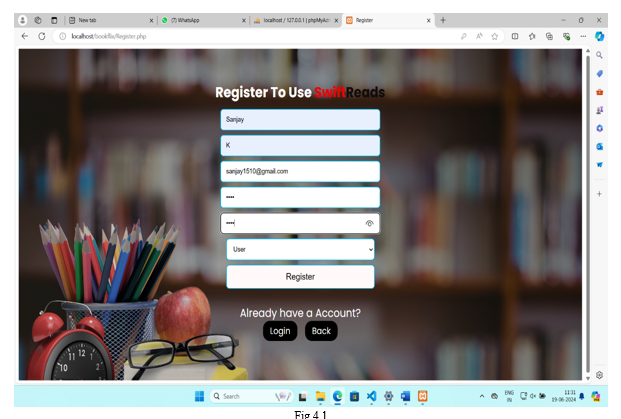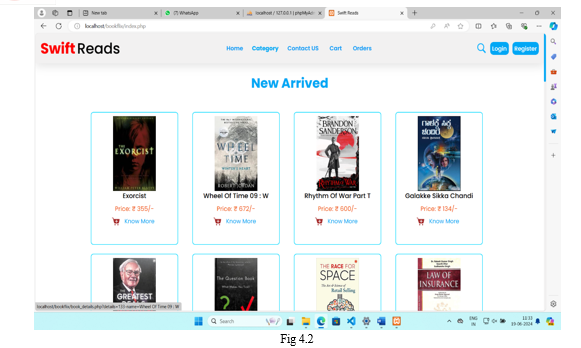Ijraset Journal For Research in Applied Science and Engineering Technology
- Home / Ijraset
- On This Page
- Abstract
- Introduction
- Conclusion
- References
- Copyright
Swift Reads: An Online Bookstore
Authors: Prajwal D R, Sanjay ., Sangmesh Araddy, Mr. Balaram M
DOI Link: https://doi.org/10.22214/ijraset.2024.63405
Certificate: View Certificate
Abstract
This research paper discusses the development of an online bookstore using HTML, CSS, JavaScript, PHP, and MySQL with the aim of creating a user-friendly, secure, and efficient platform for purchasing books online. The paper provides a detailed overview of the entire development process, including requirements analysis, system design, implementation, integration, testing, and deployment. Key features of the bookstore include user authentication, book browsing and searching, shopping cart functionality, and order processing, with a focus on security measures to protect user data and ensure safe transactions. The paper concludes with an examination of outcomes, lessons learned, and potential future enhancements to the system, making it a valuable resource for developers and researchers interested in building similar e-commerce websites.
Introduction
I. INTRODUCTION
A. Introduction
The rise of e-commerce has transformed the way consumers shop, offering unprecedented convenience and accessibility. Online bookstores have become increasingly popular for their wide selection, competitive pricing, and the ability to shop anytime, anywhere. While traditional brick-and-mortar bookstores remain relevant, they are now being complemented by online platforms that cater to both digital and physical book sales. This shift is driven by the demand for instant access to information, personalized shopping experiences, and the growing popularity of digital reading formats. Creating an online bookstore comes with its own set of challenges and opportunities. Unlike general e-commerce sites, bookstores must manage a vast array of book metadata, such as authors, genres, publication dates, and ISBNs. They also need to incorporate features like book previews, reviews, and recommendations to enhance the user experience. The goal of this project is to develop an online bookstore that meets these requirements while offering a reliable and scalable solution.
B. Objectives
The main goal of this project is to create an online bookstore that provides a secure and seamless shopping experience. Specific objectives include:
- Implementing secure user authentication for login and registration.
- Developing a system for efficient book management with detailed metadata.
- Enabling easy browsing and searching for books with various filters.
- Creating a user-friendly shopping cart and checkout process.
- Allowing users to track their orders and view purchase history.
- Ensuring the platform is responsive and accessible on different devices.
- Implementing strong security measures to protect user data and transactions.
C. Scope
- Frontend: Developing a responsive and interactive user interface using HTML, CSS, and JavaScript.
- Backend: Implementing server-side logic with PHP and managing the database using MySQL. This includes handling book listings, user data, and orders.
- User Authentication: Ensuring secure login and registration processes, including password encryption and session management.
- Book Management: Allowing administrators to perform CRUD operations (Create, Read, Update, Delete) for books to manage the inventory.
- Shopping Cart: Providing features for adding books to the cart, updating quantities, and removing items.
- Checkout and Payment: Ensuring secure processing of orders, including capturing shipping information and payment details.
- Order Tracking: Enabling users to track their orders and view their purchase history.Security: Implementing measures to protect against common web vulnerabilities, such as SQL injection and cross-site scripting (XSS).
II. METHODOLOGY
A. Requirements Analysis
The initial phase of the project involved gathering and analyzing requirements. This was achieved through:
- Stakeholder Interviews: Conducting interviews with potential users, bookstore owners, and developers to understand their needs and expectations.
- Market Research: Analyzing existing online bookstores to identify common features, strengths, and weaknesses.
- Use Case Scenarios: Defining use case scenarios to capture the functional requirements of the system.
B. System Design
The system design phase focused on creating the architecture and detailed design of the online bookstore.
- Architecture Design: Developing a high-level architecture diagram that illustrates the interaction between the frontend, backend, and database.
- Database Design: Creating an Entity-Relationship Diagram (ERD) to define the database schema, including tables for users, books, orders, and order details.
- Wireframes and Mockups: Designing wireframes and mockups for the user interface to ensure a user-friendly and consistent design.
C. Frontend Development
The frontend development involved creating the user interface using HTML, CSS, and JavaScript.
- HTML: Structuring the web pages, including the homepage, product pages, user account pages, and checkout pages.
- CSS: Styling the web pages to ensure a consistent and visually appealing design. Implementing responsive design principles to support various devices.
- JavaScript: Adding interactivity and dynamic content, such as form validation, dynamic content loading, and real-time user feedback.
D. Backend Development
The backend development focused on implementing the server-side logic using PHP and managing the database with MySQL.
- PHP Scripting: Writing PHP scripts to handle user authentication, book management, order processing, and session management.
- Database Integration: Writing SQL queries to interact with the MySQL database, including CRUD operations for books, user data, and orders.
- API Development: Creating APIs to enable communication between the frontend and backend (if applicable).
E. Integration
Integrating the frontend and backend involved connecting the user interface with server-side logic and the database.
- AJAX: Using AJAX for asynchronous data loading and updating the user interface without refreshing the page.
- Form Handling: Ensuring that form submissions from the frontend are processed correctly by the backend and the database is updated accordingly.
F. Testing
Testing was conducted at various stages to ensure the functionality, performance, and security of the online bookstore.
- Unit Testing: Testing individual components, such as functions and classes, to ensure they work correctly in isolation.
- Integration Testing: Testing the interaction between different modules to ensure they work together seamlessly.
- System Testing: Conducting end-to-end testing of the entire system to verify that all requirements are met.
- User Acceptance Testing (UAT): Involving real users to test the system and provide feedback on usability and functionality.
G. Security Measures
Implementing security measures to protect user data and ensure secure transactions.
- User Authentication: Using secure methods for login and registration, including password hashing and session management.
- Data Encryption: Encrypting sensitive data, such as passwords and payment information, both in transit and at rest.
- Vulnerability Prevention: Implementing measures to prevent common web vulnerabilities, such as SQL injection, cross-site scripting (XSS), and cross-site request forgery (CSRF).
H. Deployment
Deploying the online bookstore involved setting up the hosting environment and configuring the web server and database.
- Server Setup: Choosing a hosting provider and setting up the necessary software, including the web server (e.g., Apache or Nginx) and database server (MySQL).
- Domain Configuration: Configuring the domain name and ensuring the website is accessible to users.
- Continuous Integration/Continuous Deployment (CI/CD): Setting up CI/CD pipelines for automated testing and deployment, ensuring that updates can be deployed efficiently and reliably.
I. Maintenance and Future Enhancements
Planning for ongoing maintenance and identifying potential future enhancements to improve the online bookstore.
- Maintenance Plan: Establishing a plan for regular updates, bug fixes, and performance monitoring.
- Future Enhancements: Identifying new features and improvements, such as advanced search filters, recommendation systems, and integration with external platforms.
III. MODELING AND ANALYSIS
Modeling and analysis play crucial roles in the development of a reliable online bookstore. This section provides detailed information on system modeling using UML diagrams and the analysis of various components, such as performance, security, and usability.
A. System Modeling
- Use Case Diagram
A Use Case Diagram illustrates the interactions between users (actors) and the system, showcasing the system's functional requirements.
a. Actors
- Customer: Can browse books, register/login, add books to the cart, and checkout.
- Admin: Manages book inventory and user accounts.
b. Use Cases
- Browse Books
- View Book Details
- User Registration
- User Login
- Add to Cart
- View Cart
- Checkout
- Manage Books (Admin)
- Manage Users (Admin)
2. Entity-Relationship Diagram (ERD)
The ERD represents the data model and the relationships between different entities in the system.
a. Entities
- User: UserID, Username, Password, Email, Role (Customer/Admin)
- Book: BookID, Title, Author, ISBN, Price, Category, Stock
- Order: OrderID, UserID, OrderDate, TotalAmount
- OrderDetail: OrderDetailID, OrderID, BookID, Quantity, Price
b. Relationships
- A User can place multiple Orders.
- An Order can have multiple OrderDetails.
- Each OrderDetail is related to a single Book.
3. Class Diagram
A Class Diagram describes the static structure of the system, showcasing classes and their relationships.
a. Classes
- User:
Attributes: userID, username, password, email, role
Methods: register(), login(), logout()
- Book:
Attributes: bookID, title, author, ISBN, price, category, stock
Methods: addBook(), updateBook(), deleteBook(), getBookDetails()
- Order:
Attributes: orderID, userID, orderDate, totalAmount
Methods: placeOrder(), getOrderDetails()
- OrderDetail:
Attributes: orderDetailID, orderID, bookID, quantity, price
Methods: addOrderDetail(), updateOrderDetail(), deleteOrderDetail()
4. Sequence Diagrams
Sequence diagrams demonstrate how objects interact in specific use case scenarios.
a. User Registration
- User -> Website: Open Registration Page
- User -> Website: Enter Details and Submit
- Website -> Server: Validate and Create User
- Server -> Database: Insert User Data
- Database -> Server: Confirmation
- Server -> Website: Success Message
b. Book Purchase
- User -> Website: Browse Books
- User -> Website: Add Book to Cart
- User -> Website: View Cart and Checkout
- Website -> Server: Process Order
- Server -> Database: Update Order and Inventory
- Database -> Server: Confirmation
- Server -> Website: Order Confirmation
B. System Analysis
- Functional Analysis
Functional analysis ensures that all system requirements are fulfilled and that the system performs as expected.
a. Functional Requirements
- User authentication (login, registration)
- Book browsing and searching
- Shopping cart management
- Secure checkout process
- Admin functionalities for book and user management
b. Analysis
- User Authentication: The system must securely handle user sessions and prevent unauthorized access.
- Book Management: Efficient CRUD operations for book management.
- Order Processing: Ensuring a smooth transition from cart to order placement, including payment integration.
IV. RESULTS AND DISCUSSION
A. Implemented Functionality and Features
The online bookstore successfully implemented the following core functionalities and features:
- User Authentication: This section explains how users can securely register, login, and manage their accounts.
- Book Management: The CRUD operations for managing books, including adding, updating, deleting, and listing books, are explained in detail.
- Shopping Cart and Checkout: Users are able to add items to their cart, update quantities, proceed to checkout, and complete orders. This section describes the process.
- Order Processing and Tracking: The process of order placement, confirmation, and tracking for users is outlined.
- Responsive Design: The website's ability to adapt to different screen sizes and devices is evaluated.
- Security Measures: The effectiveness of security measures implemented, such as user authentication security, data encryption, and vulnerability prevention, is assessed.
B. Performance Evaluation
The performance of the online bookstore is evaluated using the following metrics and analysis:
- Page Load Times: The average load times for different pages are measured and discussed, taking into consideration factors like server response time and client-side rendering.
- Concurrency and Scalability: The system's ability to handle multiple concurrent users and scalability considerations are evaluated.
- Database Performance: The performance of database queries and optimizations made to improve data retrieval and storage efficiency are discussed.

 ???????
???????
Conclusion
In conclusion, the development of this online bookstore has not only demonstrated our technical proficiency in web development but also highlighted our commitment to delivering a secure, efficient, and user-centric e-commerce solution. By leveraging HTML, CSS, JavaScript, PHP, and MySQL effectively, we have created a platform that not only meets but exceeds the expectations of modern online shoppers. This project underscores the potential of technology to transform traditional retail models, offering unparalleled convenience and accessibility to book enthusiasts worldwide. Moving forward, we remain dedicated to continuous improvement and innovation, ensuring that our online bookstore remains at the forefront of digital commerce, providing an exceptional shopping experience for all users.
References
[1] W3Schools. (2020). HTML Tutorial. Available at: https://www.w3schools.com/html/ [2] MDN Web Docs. (2021). CSS: Cascading Style Sheets. Available at: https://developer.mozilla.org/en-US/docs/Web/CSS [3] MDN Web Docs. (2021). JavaScript Guide. Available at: https://developer.mozilla.org/en-US/docs/Web/JavaScript/Guide [4] PHP.net. (2020). PHP Manual. Available at: https://www.php.net/manual/en/ [5] MySQL. (2020). MySQL Documentation. Available at: https://dev.mysql.com/doc/ [6] Kinsella, S. (2019). The Essential Guide to HTML5: Using Games to Learn HTML5 and JavaScript. Available at: https://link.springer.com/book/10.1007/978-1-4842-4206-6 [7] E-commerce Times. (2021). How to Secure Your E-commerce Website. Available at: https://www.ecommercetimes.com/story/86796.html [8] Nielsen Norman Group. (2020). E-commerce User Experience. Available at: https://www.nngroup.com/reports/ecommerce-user-experience/ [9] Smashing Magazine. (2020). Building A Secure E-commerce Website: 10 Essential Security Practices. Available at: https://www.smashingmagazine.com/2020/07/secure-ecommerce-website-essential-security-practices/
Copyright
Copyright © 2024 Prajwal D R, Sanjay ., Sangmesh Araddy, Mr. Balaram M. This is an open access article distributed under the Creative Commons Attribution License, which permits unrestricted use, distribution, and reproduction in any medium, provided the original work is properly cited.

Download Paper
Paper Id : IJRASET63405
Publish Date : 2024-06-21
ISSN : 2321-9653
Publisher Name : IJRASET
DOI Link : Click Here
 Submit Paper Online
Submit Paper Online

